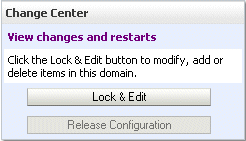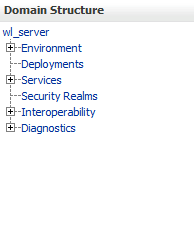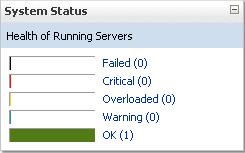3 Overview of Administration Consoles
This chapter includes the following topic:
Using the WebLogic Server Administration Console
The WebLogic Server Administration Console is a web browser-based, graphical user interface that you use to manage a WebLogic Server domain. It provides the starting point for essential operations, administration, automation, and management.
This topic includes the following sections:
About the WebLogic Server Administration Console
The WebLogic Server Administration Console is a web browser-based, graphical user interface that you use to manage a WebLogic Server domain. A WebLogic Server domain is a logically related group of WebLogic Server resources that you manage as a unit. A domain includes one or more WebLogic Servers and may also include WebLogic Server clusters. Clusters are groups of WebLogic Servers instances that work together to provide scalability and high availability for applications. You deploy and manage your applications as part of a domain.
One instance of WebLogic Server in each domain is configured as an Administration Server. The Administration Server provides a central point for managing a WebLogic Server domain. All other WebLogic Server instances in a domain are called Managed Servers. In a domain with only a single WebLogic Server instance, that server functions both as Administration Server and Managed Server. The Administration Server hosts the WebLogic Server Administration Console, which is a web application accessible from any supported web browser with network access to the Administration Server. Managed Servers host applications.
Use the WebLogic Server Administration Console to:
-
Configure, start, and stop WebLogic Server instances
-
Configure WebLogic Server clusters
-
Configure WebLogic Server services, such as database connectivity (JDBC) and messaging (JMS)
-
Configure security parameters, including managing users, groups, and roles
-
Configure and deploy your applications
-
Monitor server and application performance
-
View server and domain log files
-
View application deployment descriptors
-
Edit selected run-time application deployment descriptor elements
-
Control (start, stop, and restart) managed Coherence servers
-
Create and configure Coherence clusters
WebLogic Server Administration Console Online Help
The WebLogic Server Administration Console includes a complete help system. It has two parts:
-
How do I...?, which documents procedures for tasks you can perform using the WebLogic Server Administration Console.
-
WebLogic Server Administration Console Reference, which provides reference information for each page in the WebLogic Server Administration Console, including descriptions of the attributes you can set using the WebLogic Server Administration Console.
You can access the WebLogic Server Administration Console online help either through the WebLogic Server Administration Console itself, or in Oracle WebLogic Server Administration Console Online Help.
Console Errors
Messages (including information, warning, and error messages) can be generated and logged in the course of using the WebLogic Server Administration Console. You can view WebLogic Server logs from the Diagnostics > Log Files page of the WebLogic Server Administration Console.
Starting the WebLogic Server Administration Console
This section contains instructions for starting the WebLogic Server Administration Console.
To use the WebLogic Server Administration Console, use one of the supported web browsers for your environment. See Supported Configurations in What's New in Oracle WebLogic Server. If your web browser is not a supported browser, you may experience functional or formatting problems when using the WebLogic Server Administration Console.
To start the WebLogic Server Administration Console:
Enabling the WebLogic Server Administration Console
By default, the WebLogic Server Administration Console is enabled. If you disable it, you can reenable it using the WebLogic Scripting Tool (WLST). Start the Administration Server, then invoke WLST and use the following commands:
Example 3-1 Using WLST to Reenable the Console
connect("username","password")
edit()
startEdit()
cmo.setConsoleEnabled(true)
save()
activate()
The following attribute(s) have been changed on MBeans which require server re-start.
MBean Changed : com.bea:Name=mydomain,Type=Domain Attributes changed :
ConsoleEnabled
Activation completed
disconnect()
exit()
For information about using WLST, see Understanding the WebLogic Scripting Tool.
Elements of the WebLogic Server Administration Console
The WebLogic Server Administration Console user interface includes the following panels:
Change Center
This is the starting point for using the WebLogic Server Administration Console to make changes in WebLogic Server. See Using the Change Center.
Domain Structure
This panel contains a tree structure you can use to navigate to pages in the WebLogic Server Administration Console. Select any of the nodes in the Domain Structure tree to view that page. Click a + (plus) icon in the Domain Structure to expand a node and a - (minus) icon to collapse the node.
How Do I...
This panel includes links to online help tasks that are relevant to the current Console page.
Tool Bar
The tool bar at the top of the Console includes the following elements:
| Tool Bar Element | Description |
|---|---|
|
Welcome message |
Indicates user name with which you have logged into the Console. |
|
Connected to: |
The IP address and port you used to connect to the Console. |
|
Home |
A link to the top page of the Console. |
|
Log Out |
Click to log out of the Console. |
|
Preferences |
A link to a page where you can change some Console behavior. |
|
Record |
Starts recording your configuration actions as a series of WebLogic Scripting Tool (WLST) commands. Writes the commands to a separate file that you can replay in WLST. See Record WLST Scripts in Oracle WebLogic Server Administration Console Online Help. |
|
Help |
A link to the WebLogic Server Administration Console Online Help. |
|
Search |
A text field in which you can enter a string to find any WebLogic Server Configuration MBeans that contain the string you specified in their name. |
Breadcrumb Navigation
A series of links that show the path you have taken through the WebLogic Server Administration Console's pages. You can click on any of the links to return to a previously-visited page.
System Status
The System Status panel reports on the number of information, error, and warning messages that have been logged. You can view these messages in the server log files, which you can access from the WebLogic Server Administration Console at Diagnostics > Log Files.
Using the Change Center
The starting point for using the WebLogic Server Administration Console to make changes in your WebLogic Server domain is the Change Center. The Change Center provides a way to lock a domain configuration so you can make changes to the configuration while preventing other accounts from making changes during your edit session.
The domain configuration locking feature is always enabled in production domains. It can be enabled or disabled in development domains. It is disabled by default when you create a new development domain. See Enable and disable the domain configuration lock in Oracle WebLogic Server Administration Console Online Help.
To change a production domain's configuration, you must:
-
Locate the Change Center in the upper left of the WebLogic Server Administration Console screen.
-
Click the Lock & Edit button to lock the configuration edit hierarchy for the domain.
-
Make the changes you desire on the relevant page of the Console. Click Save on each page where you make a change.
-
When you have finished making all the desired changes, click Activate Changes in the Change Center.
As you make configuration changes using the WebLogic Server Administration Console, you click Save (or in some cases Finish) on the appropriate pages. This does not cause the changes to take effect immediately. The changes take effect when you click Activate Changes in the Change Center. At that point, the configuration changes are distributed to each of the servers in the domain. If the changes are acceptable to each of the servers, then they take effect. If any server cannot accept a change, then all of the changes are rolled back from all of the servers in the domain. The changes are left in a pending state; you can then either edit the pending changes to resolve the problem or revert the pending changes.
Undoing Changes
You can revert any pending (saved, but not yet activated) changes by clicking Undo All Changes in the Change Center. You can revert any individual change by going to the appropriate page in the WebLogic Server Administration Console and restoring the attribute to its previous value.
Releasing the Configuration Lock
You release the configuration lock as follows:
-
Before you make changes, click Release Configuration in the Change Center to release the lock explicitly.
-
After you save changes, click Activate Changes or Undo All Changes in the Change Center to release the lock implicitly.
Stopping the Administration Server does not release the configuration lock. When the Administration Server starts again, the configuration lock is in the same state it was in when the Administration Server was shut down, and any pending changes are preserved.
How Change Management Works
To provide a secure, predictable means for distributing configuration
changes in a domain, WebLogic Server imposes a change management process that
loosely resembles a database transaction. The configuration of a domain is
represented on the file system by a set of XML configuration files, centralized in
the config.xml file, and at run time by a hierarchy of
Configuration MBeans. When you edit the domain configuration, you edit a separate
hierarchy of Configuration MBeans that resides on the Administration Server. To
start the edit process, you obtain a lock on the edit hierarchy to prevent other
people from making changes. When you finish making changes, you save the changes to
the edit hierarchy. The changes do not take effect, however, until you activate
them, distributing them to all server instances in the domain. When you activate
changes, each server determines whether it can accept the change. If all servers are
able to accept the change, they update their working configuration hierarchy and the
change is completed.
For more information about change management, see Managing Configuration Changes in Understanding Domain Configuration for Oracle WebLogic Server.
Dynamic and Non-Dynamic Changes
Some changes you make in the WebLogic Server Administration Console take
place immediately when you activate them. Other changes require you to restart the
server or module affected by the change. These latter changes are called
non-dynamic changes. Non-dynamic changes are indicated in the WebLogic
Server Administration Console with this warning icon: ![]()
Description of the illustration nondynchange1.gif
Changes to dynamic configuration attributes become available once they are activated, without restarting the affected server or system restart. These changes are made available to the server and run-time hierarchies once they are activated. Changes to non-dynamic configuration attributes require that the affected servers or system resources be restarted before they become effective.
If a change is made to a non-dynamic configuration setting, no changes to dynamic configuration settings will take effect until after restart. This is to assure that a batch of updates having a combination of dynamic and non-dynamic attribute edits will not be partially activated.
Note that WebLogic Server's change management process applies to changes in domain and server configuration data, not to security or application data.
Viewing Changes
You can view any changes that you have saved, but not yet activated, by clicking the View Changes and Restarts link in the Change Center. The View Changes and Restarts link presents two tabs, Change List and Restart Checklist:
-
The Change List page presents all changes that have been saved, but not yet activated.
-
The Restart Checklist lists all servers for which non-dynamic changes have been activated, but which require restarts before the changes become effective.



